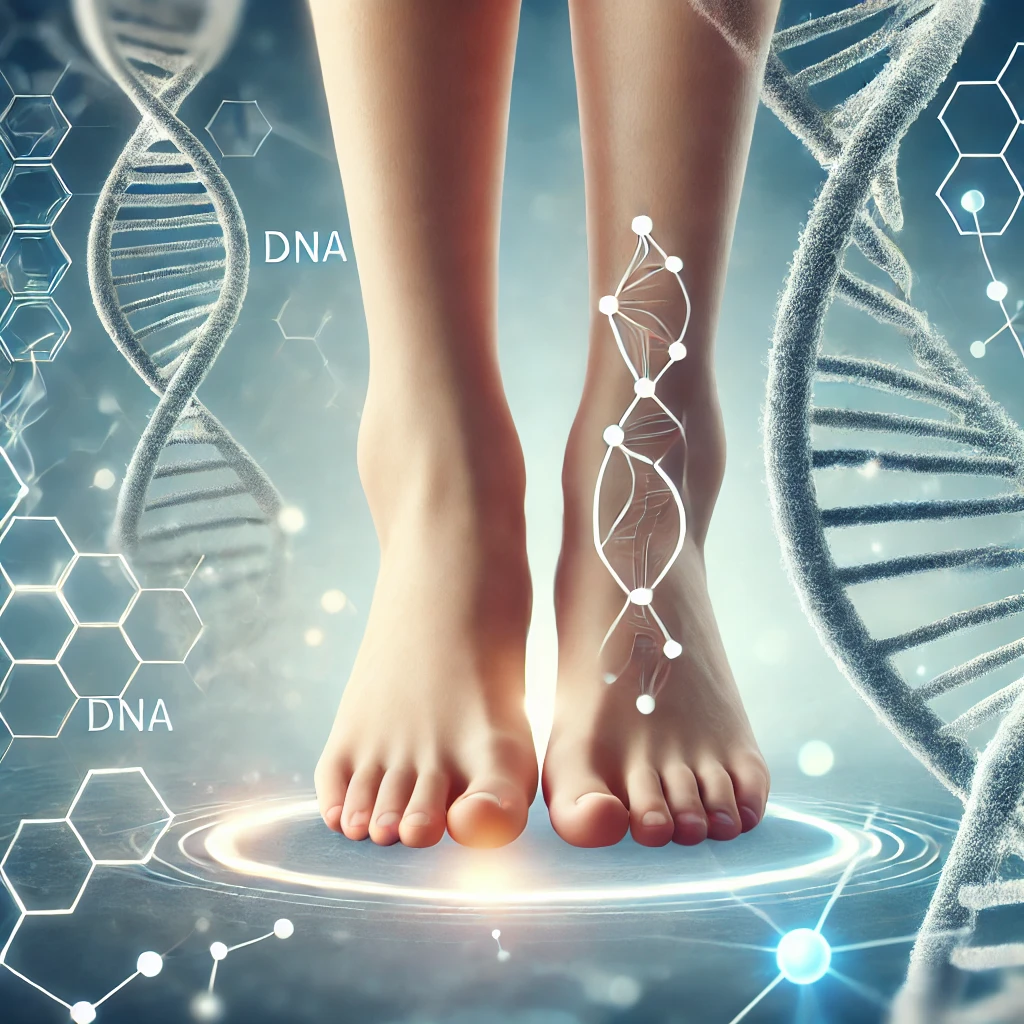Introduction
When it comes to foot health, most people think of external factors like shoes, injuries, or physical activity. However, genetics plays a significant role in determining the structure, function, and overall health of our feet. From arch height to foot pain susceptibility, our DNA influences various aspects of foot health, making it essential to understand the hereditary factors at play.
In this article, we’ll explore how genetics impact foot health, common inherited foot conditions, and what steps you can take to manage or prevent foot-related issues.
Understanding Foot Genetics

How Do Genes Influence Foot Shape and Structure?
Our genes dictate the fundamental blueprint of our bodies, including our feet. The size, shape, arch height, and even the way we walk are inherited traits passed down from our parents. Some people are born with naturally strong and well-aligned feet, while others inherit foot structures that may predispose them to pain, instability, or deformities.
Inherited Genetic Traits in Foot Health
Several foot-related traits are inherited, including:
- Arch type (flat feet, high arches, normal arches)
- Toe length and alignment (long toes, short toes, or deformities like hammer toes)
- Bone structure (wide feet, narrow feet, bunion predisposition)
- Gait mechanics (pronation, supination, foot strike patterns)
While genes set the foundation, environmental factors such as lifestyle, footwear, and activity level also influence how these traits manifest over time.
Common Genetic Foot Conditions
Some foot problems run in families, affecting generations due to genetic predisposition. Here are some of the most common hereditary foot conditions:
Flat Feet (Pes Planus)

Flat feet occur when the arches fail to develop properly, leading to a flattened sole. This condition is often inherited and can cause:
- Foot pain and fatigue
- Knee, hip, and lower back discomfort
- Increased risk of ankle sprains
While some people with flat feet experience no issues, others may require orthotics, supportive footwear, or even physical therapy to manage symptoms.
High Arches (Pes Cavus)

On the opposite end of the spectrum, some people inherit high arches, which can cause:
- Foot instability
- Increased pressure on the ball and heel of the foot
- Greater risk of stress fractures and plantar fasciitis
Custom orthotics and proper footwear can help distribute pressure more evenly and provide better support.
Bunions (Hallux Valgus)

Bunions are bony protrusions that form at the base of the big toe, causing misalignment and discomfort. Genetics plays a major role in bunion development, though tight shoes and high heels can worsen the condition. Symptoms include:
- Swelling and redness around the big toe joint
- Pain while walking
- Difficulty finding comfortable shoes
Preventative measures such as wearing wide-toe shoes and using bunion pads can help slow progression.
Hammer Toes

Hammer toes occur when the toe bends abnormally at the middle joint, often due to inherited foot mechanics. This condition can lead to:
- Painful corns and calluses
- Difficulty walking
- Need for corrective surgery in severe cases
Regular stretching, toe exercises, and wearing properly fitting shoes can help manage this condition.
Other Genetic Foot-Related Disorders
Clubfoot
A congenital condition where the foot is twisted out of shape. It often runs in families and requires early intervention to correct alignment.
Morton’s Neuroma
A painful nerve condition between the toes that may have a genetic component, though it’s also influenced by footwear and foot mechanics.
Tarsal Coalition
A condition where two or more foot bones fuse abnormally, often inherited, leading to stiffness and pain.
How Genetics Influence Foot Biomechanics
Foot biomechanics, including the way we walk, run, and distribute weight, are partially inherited. Some inherited traits affecting biomechanics include:
- Pronation or supination tendencies (overpronation leads to collapsed arches, while supination causes excessive outward rolling)
- Tendon flexibility and muscle strength (some people naturally have weaker or tighter foot muscles)
- Leg length differences (minor discrepancies can cause gait imbalances)
Proper shoe selection, stretching, and strengthening exercises can help mitigate genetic biomechanical issues.
The Link Between Genetics and Foot Pain
Not everyone experiences foot pain in the same way, and genetics play a role in determining how susceptible someone is to chronic or recurring foot discomfort. Several factors contribute to genetically influenced foot pain, including:
Why Some People Are More Prone to Foot Pain
Certain foot structures, such as flat feet or high arches, can place excess stress on different parts of the foot, leading to conditions like plantar fasciitis, Achilles tendonitis, or stress fractures. Additionally, genetics influence:
- Bone density and structure – Some people inherit weaker bones, making them more prone to fractures.
- Pain sensitivity – Some individuals have a lower pain threshold due to genetic differences in nerve function.
- Inflammatory conditions – Autoimmune diseases like rheumatoid arthritis, which can cause foot pain, often have a hereditary component.
Chronic Foot Pain and Hereditary Conditions
If foot pain runs in your family, it’s important to take proactive measures, such as wearing supportive footwear, maintaining a healthy weight, and practicing foot-strengthening exercises. Managing inherited conditions early can prevent long-term damage.
Environmental vs. Genetic Factors in Foot Health
While genetics play a significant role in foot health, environmental factors also contribute to foot-related issues. The interaction between nature (genetics) and nurture (lifestyle) determines overall foot well-being.
Lifestyle Choices That Impact Foot Health
Even if you inherit foot conditions, how you care for your feet makes a big difference. Some key lifestyle factors that influence foot health include:
- Footwear choices – Wearing ill-fitting shoes can exacerbate genetic foot problems like bunions and hammertoes.
- Activity level – High-impact sports may worsen hereditary foot conditions if not properly managed.
- Weight and nutrition – Excess body weight puts additional strain on the feet, increasing pain and discomfort.
Genetics vs. Environment: Which Has a Bigger Impact?
While genetics set the foundation, proper foot care can mitigate many hereditary issues. For example, someone with a genetic predisposition to bunions may never develop severe symptoms if they wear supportive shoes and avoid high heels. Conversely, poor foot care can lead to problems even in people without a genetic predisposition.
Diagnosing Genetic Foot Conditions
Medical Tests and Genetic Screenings
If foot problems run in your family, you may benefit from a genetic screening or biomechanical assessment by a podiatrist. Diagnostic methods include:
- X-rays and MRIs to evaluate bone structure
- Gait analysis to assess walking patterns
- Genetic testing for hereditary disorders like Charcot-Marie-Tooth disease (which affects nerve function in the feet)
Family History and Genetic Counseling
Understanding your family history can help you anticipate potential foot issues. If multiple family members suffer from the same condition, consulting a genetic counselor or podiatrist can provide insights on prevention and management.
The Importance of Early Diagnosis
Early intervention is crucial for managing inherited foot problems. Addressing issues before they worsen can prevent long-term complications such as chronic pain, mobility limitations, or the need for surgery.
Managing and Treating Genetic Foot Issues
Even though genetic factors influence foot health, several treatment options can help alleviate symptoms and improve comfort.
Non-Surgical Treatments
For mild to moderate genetic foot conditions, non-invasive approaches include:
- Orthotics – Custom shoe inserts that provide arch support and correct alignment
- Physical therapy – Strengthening and stretching exercises to improve foot function
- Pain management – Anti-inflammatory medications, ice therapy, and massages
Surgical Options for Severe Cases
When non-surgical treatments fail, surgery may be necessary to correct structural deformities. Common procedures include:
- Bunionectomy – Removal of bunions and realignment of the big toe
- Tendon release for hammertoes – Straightening curled toes
- Foot fusion surgeries – Used for severe arthritis or tarsal coalition
Long-Term Management Strategies
For individuals with hereditary foot problems, long-term strategies can help maintain mobility and reduce discomfort:
- Regular podiatrist visits – Monitoring for changes in foot structure or function
- Stretching and strengthening exercises – To keep foot muscles strong and flexible
- Supportive footwear – Shoes with good arch support, cushioning, and a wide toe box
Preventative Measures for Those with Genetic Foot Risks
If you have a family history of foot problems, taking proactive steps can help prevent issues from worsening.
Importance of Early Intervention
Early action is key to preventing hereditary foot issues from becoming severe. Addressing minor discomfort early can prevent long-term complications.
Recommended Footwear and Lifestyle Habits
Choosing the right footwear can make a huge difference. Consider:
- Arch-supporting shoes to help with flat feet or high arches
- Wide-toe box shoes to prevent bunions and hammertoes
- Shock-absorbing soles to reduce impact on joints
Lifestyle habits like maintaining a healthy weight, avoiding prolonged standing on hard surfaces, and engaging in low-impact exercises (like swimming or cycling) can also help.
Regular Checkups with Podiatrists
Seeing a podiatrist regularly ensures that any developing issues are caught early. Regular foot assessments, especially for those with genetic risks, can prevent complications.
Future of Genetics in Foot Health
The field of genetics and personalized medicine is evolving rapidly, offering new insights into foot health.
Advances in Genetic Research
Scientists continue to study the genetic basis of foot conditions, paving the way for targeted treatments and early intervention strategies.
Potential for Gene Therapy in Foot-Related Conditions
Gene therapy, which involves altering specific genes to correct inherited disorders, is being explored as a potential treatment for foot deformities and neuromuscular diseases.
Predictions for the Future of Foot Health Care
With advancements in technology, we may see:
- More precise genetic testing to predict foot conditions before symptoms arise
- Custom 3D-printed orthotics based on genetic and biomechanical analysis
- Targeted gene treatments for inherited foot deformities
As research progresses, the future of foot health care looks promising, with potential breakthroughs that could drastically improve treatment and prevention strategies.
Conclusion
Genetics plays a fundamental role in determining foot health, from arch structure to susceptibility to pain and deformities. While you can’t change your genes, you can take proactive steps to manage and prevent inherited foot conditions. By choosing the right footwear, maintaining proper foot care habits, and consulting with specialists when needed, you can ensure that your feet remain strong and healthy for years to come.
Understanding your genetic predisposition empowers you to make informed decisions about your foot health. Whether through lifestyle adjustments, medical interventions, or advancements in genetic research, the future of foot care is bright for those willing to take charge of their health.
Frequently Asked Questions
1. Can genetics determine the exact shape of my feet?
Yes, genetics play a significant role in determining foot shape, including arch height, toe length, and overall structure. However, environmental factors such as footwear and activity level can also influence foot development over time.
2. Are bunions always inherited, or can they develop due to lifestyle?
While bunions have a strong genetic component, lifestyle factors like wearing tight shoes or high heels can exacerbate the condition. If bunions run in your family, choosing supportive footwear can help prevent progression.
3. How can I prevent genetic foot conditions from worsening?
Preventative measures include wearing proper footwear, using custom orthotics, doing foot-strengthening exercises, and regularly consulting a podiatrist. Early intervention can significantly reduce discomfort and prevent complications.
4. Is foot pain hereditary?
Certain foot structures and conditions that lead to pain, such as flat feet, high arches, or arthritis, can be inherited. However, proper foot care can help manage and reduce pain.
5. What role does genetics play in sports injuries related to feet?
Genetic factors like foot shape, tendon flexibility, and gait mechanics can influence the risk of sports injuries. Individuals with inherited conditions such as weak arches or overpronation may be more prone to injuries like plantar fasciitis or stress fractures.











Appreciation too my father who infored me regsrding tyis website,
thius blg iss really remarkable.